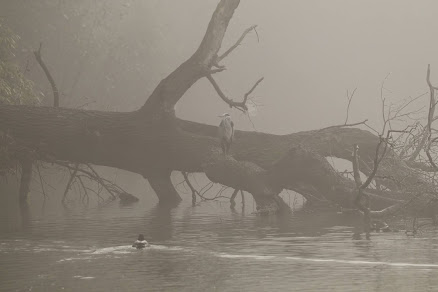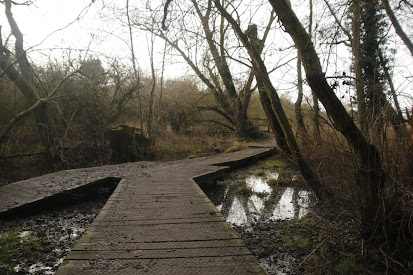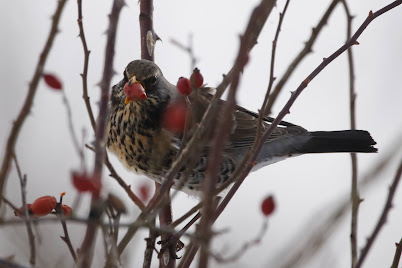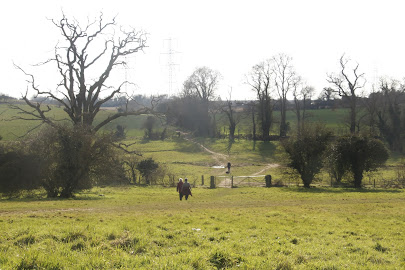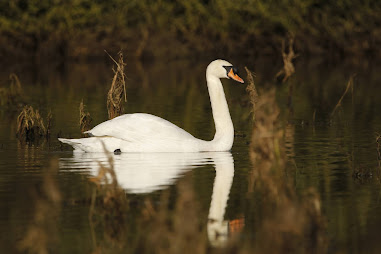When it comes to good birdwatching sites, Ipswich doesn't really come to mind. Urban sprawl has taken its toll on the land, but amongst all the concrete some decent areas of wildlife habitat still remains. The main concentration is along the River Gipping, a large green vein flowing through a grey land, a haven for wildlife. Also of note is the Belstead Brook combination of nature reserves, a good area of rare habitats, always worth a view.
Because of the endless sprawl of concrete, and being cut off from the surrounding countryside, bird numbers aren't as high as rural areas, so there aren't as many to spot. As a result the natural places can be a bit more quiet than out in the countryside. But somehow small dots of wildlife habitats survive and provide some much needed homes for wildlife.
A lot of the resident birds have become used to humans over the years and are quite tolerant of people, allowing you to get fairly close to them. For the record Christchurch Park has not been included, I have given a separate blog for that site. The rest of the birdy places are listed below.
RED-THROATED DIVER & SHAG on the Ipswich Waterfront
For a week in late October a RED THROATED DIVER spent its time on the River Orwell, around the expensive yachts that float around the town's waterfront. This was only my second record of this species in Ipswich, although its a common bird on the not too distant coast. Never very well the bird soon succumbed and was later found dead. There were a few birders twitching the bird, its very unusual to find any birdwatchers in Ipswich which was nice.
In the beginning of March a pair of SHAG were on the waterfront, smaller than cormorants, green-black, one also had a crest. Although nesting in large numbers on the cliffs up north, in Suffolk they are quite rare with only a few turning up each year. All my Suffolk records have been from this location, all at this period, which suggests birds migrating to their breeding grounds. Unfortunately as I was just passing through I had no bins or camera - typical.
Pipers Vale
Part of the Orwell country Park, the only country park around Ipswich, Pipers Vale is an area of scrubby grassland and secondary woodland along the River Orwell. The one draw is the fact that a path takes you under the mighty Orwell Bridge, a dramatic and picturesque construction.
When I visited on the 30/12/2021 the tide was high and a large flock of REDSHANK were roosting on the beach, but were soon disturbed by dog walkers. The usual estuarine DUCKS were present with SHELDUCK, MALLARD and PINTAIL just off shore. Further out on the deeper water were several RED-BREASTED MERGANSER, a small flock of LITTLE GREBE with some GREAT CRESTED GREBES even further out still.
I did a second visit on 12/3 when again it was high tide. The end of winter, and the period I'm blogging, there were a few remnant ducks of the winter season with a couple of WIGEON and PINTAIL, close to shore. Further out there were three RED BREASTED MERGANSERS, three LITTL GREBE and a GREAT CRESTED GREBE in the distance, all typical winter birds of the estuary. These birds will move on over the couple of weeks with only a small number of birds nesting along the Orwell. Pipers Vale is pretty much the best area within the boundaries of Ipswich in which to see estuarine birds, with views beyond the man made docks.
Chantry Park
The largest park in Ipswich, Chantry Park is also its most rural, being situated on the south-western edge of the town. Being a municipal park there are huge areas of of open grass, loved by dog walkers with some landscaped gardens round the stately home in the centre. These all have good examples of old trees, including some dramatic cedars around the gardens. However despite all these man-made trimmings its easy to get away from the people who use it. There is plenty of decent habitats for birds around the edges of the park, with lots of scrubby, wooded areas also with some rough grassland. These all attract lots of species and being largely parkland it has plenty of MISTLE THRUSH and GREEN WOODPECKERS.
On one visit on 27/11 the land was covered in a thick layer of fog which provided atmospheric photos. I saw a marauding SPARROWHAWK and as usual for this winter, so far, lots of REDWING.
Sir Bobby Robson's Bridge
This is a nice spot near to the centre of town, just a stone's throw from the council buildings. A footbridge crosses the river where the Orwell and Gipping meet, the last place where the river becomes tidal. It was concreted in the 60s, along the river's sides and at low tide lots of shopping trolleys and road cones are revealed. Bird-wise, this is a good spot for REDSHANK and LITTLE EGRET, and OYSTERCATCHER nest on the surrounding warehouse roofs in summer.
By the time I made a further visit on 16/3/2021, birds were creating breeding territories on the river. A pair of MUTE SWANS have nested on the river bank by the bridge for at least the past nine years and were present again this year. Also present were a pair of CANADA GEESE and some MALLARDS.
Belstead Brook
This is the wildlife area in Ipswich, a chain of nature reserves that form a green underbelly to the town. Following the Belstead river, this informal country park consists of ancient woodland, wet grassland, reedbed, wet woodland, as well as parkland. It attracts a large variety of nature, famous for its bluebell displays in Spring Wood.
I visited on 27/1, walking round Spring Wood, an ancient forest that has stood for as long as records begin; also Bobbit's Lane meadows, rough grassland that has flooded areas that transforms to reeds and bulrushes; and Ashground Plantation an area of seasonally flooded woodland.
In Spring Wood there was coppicing in commencement, a practice which opens up the woodland canopy for its amazing display of BLUEBELLS in Spring. Lots of the commoner birds were out in force twinkling away in the background to my walk. The first singing SONG THRUSH of the year was heard and some REDWINGS were on the edge of the wood, signs of Spring and Winter together.
In the bulrushes on Bobbit's Lane Meadow, a CETTI'S WARBLER was in song, they have colonised every nook and cranny of Suffolk. Ashground Plantation was flooded the brook had burst its bank, and with water standing under the canopy of the trees walking was limited. A SPARROWHAWK marauded along the trees, whilst in the neihbouring sewage farm a GREY WAGTAIL was present.
Whilst out here I met a fellow birdwatcher who was collecting all the masses of rubbish dumped in the area and he gave me a heads up to a bird in another part of town...
HOODED MERGANSER on the River Gipping
I was actually told a BUFFLEHEAD was present, along the river Gipping. An American form of goldeneye, I was desperate to see a bird I've never spotted before, especially in Ipswich. However it turned out to be the HOODED MERGANSER, a bird that has been hanging around Ipswich for at least eighteen months. Its fine as I haven't seen the bird for a while, so it wasn't too much of a disappointment. The bird, like all male ducks, was very colourful, standing out amongst all the commoner birds, such as MOORHENS and GULLS. Most distinctive was its "hood" a massive tear drop of white creating a long tuft to the back of its head, giving the bird its name.
The bird was present by Tanner's View, a very urban part of the river with housing developments on one side and warehouses on the other. The hooded merganser spent its time on the opposite bank of the river, the one where there is no human access where it stayed amongst the MALLARDS and COOT.
The river Gipping is a green vein that flows through the town of Ipswich, with its reed fringes and trees providing lots of habitat for nature. Like a lot of the course of the Gipping, trees have been planted along the river, a good deed as this prevents erosion of the river bank and slows down flooding.
On a visit on 16/3 a pair of MUTE SWAN and CANADA GEESE were all present on the river, hoping to breed. Further down the river, past the first viaduct and close to the fringes of the town were a pair of KINGFISHERS, calling out with their dunnock-sounding call. I hope they are a breeding pair, the area they were in had plenty of riverside trees, their favourite nesting habitat. Kingfishers are one of those jewels of birds, not common, not rare, but always worth a note, and are beautiful to see, maybe our most colourful native bird.
OK, so I can't pretend that Ipswich is good for birds, as it really isn't. Even though I spend much time in the area, its where I live, I just don't see the birds I do out in the countryside. However from time to time the odd bird turns up that makes the place interesting. In lockdown, with all the main reserves closed or too far away, winter has not been that great for birdwatching, and as a result there has been a emphasis on local sites. This has made birdwatching in Ipswich that more important than in normal times. Anyway, whilst I still live in this town, I will continue to birdwatch here, so maybe there will be a sighting to reward my patience. Or, most likely, not.






